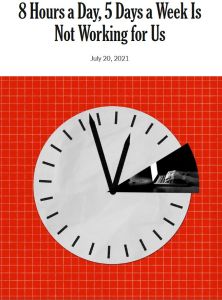Acesse a sua conta getAbstract para obter o resumo!

Acesse a sua conta getAbstract para obter o resumo!
Bryce Covert
8 Hours a Day, 5 Days a Week Is Not Working for Us
The New York Times, 2021
Sobre o que é?
Working less is beneficial to your well-being and could help reduce employment disparities.
Recommendation
While the pandemic brought about various restrictions, work-from-home schedules freed many Americans from time-consuming commutes. However, instead of investing their new-found time in personal pursuits, they worked three hours a day more. Entering the post-pandemic era, employees and employers are now fiercely debating when and whether they’ll return to the office. Economics journalist Bryce Covert is taking the debate a step further, asking not only whether employers should be allowed to dictate when and where their employees work, but suggesting they shouldn’t say how much employees should work, either.
Summary
About the Author
Bryce Covert is an independent journalist covering the economy. Her work has appeared in The Nation, The Intercept, and The New York Times.

















Comment on this summary